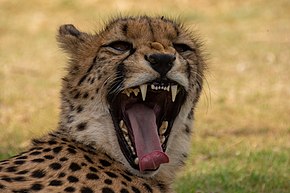
Teeth are common to most vertebrates, but mammalian teeth are distinctive in having a variety of shapes and functions. This feature first arose among early therapsids during the Permian, and has continued to the present day. All therapsid groups with the exception of the mammals are now extinct, but each of these groups possessed different tooth patterns, which aids with the classification of fossils.
Most extant mammals including humans are diphyodonts, i.e. they have an early set of deciduous teeth and a later set of permanent or "adult" teeth. Notable exceptions are elephants, kangaroos, and manatees, all of which are polyphyodonts, i.e. having teeth that are continuously being replaced.
Mammal teeth include incisors, canines, premolars, and molars, not all of which are present in all mammals. Various evolutionary modifications have occurred, such as the lack of canines in Glires, the development of tusks from either incisors (elephants) or canines (pigs and walruses), the adaptation of molars into flesh-shearing carnassials in Carnivora, and others.